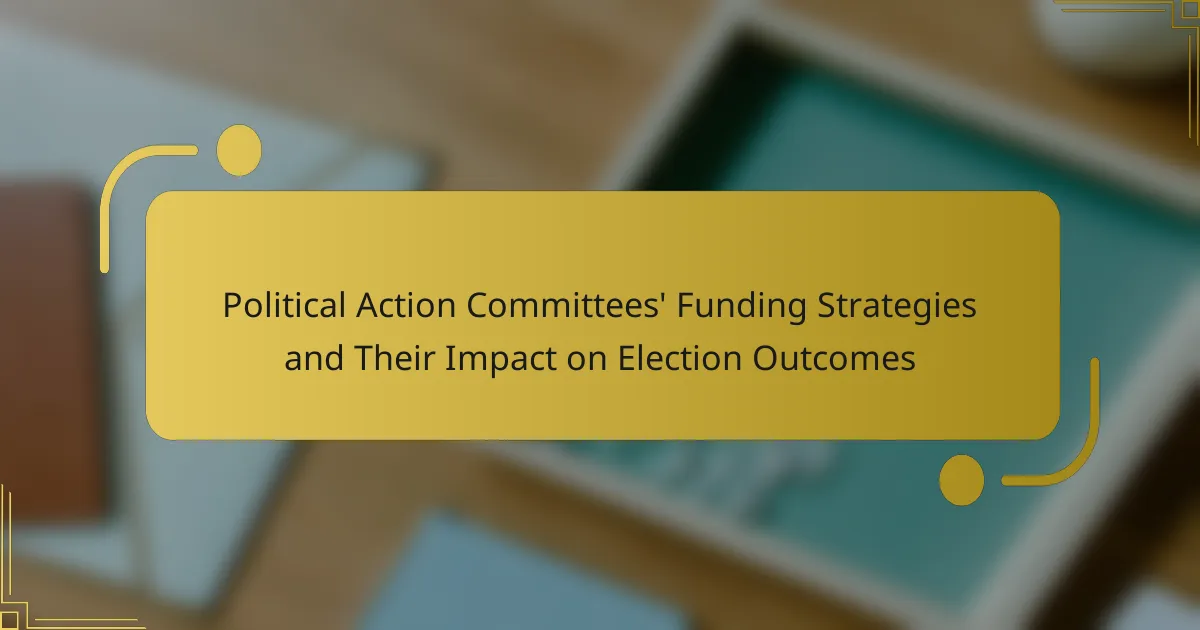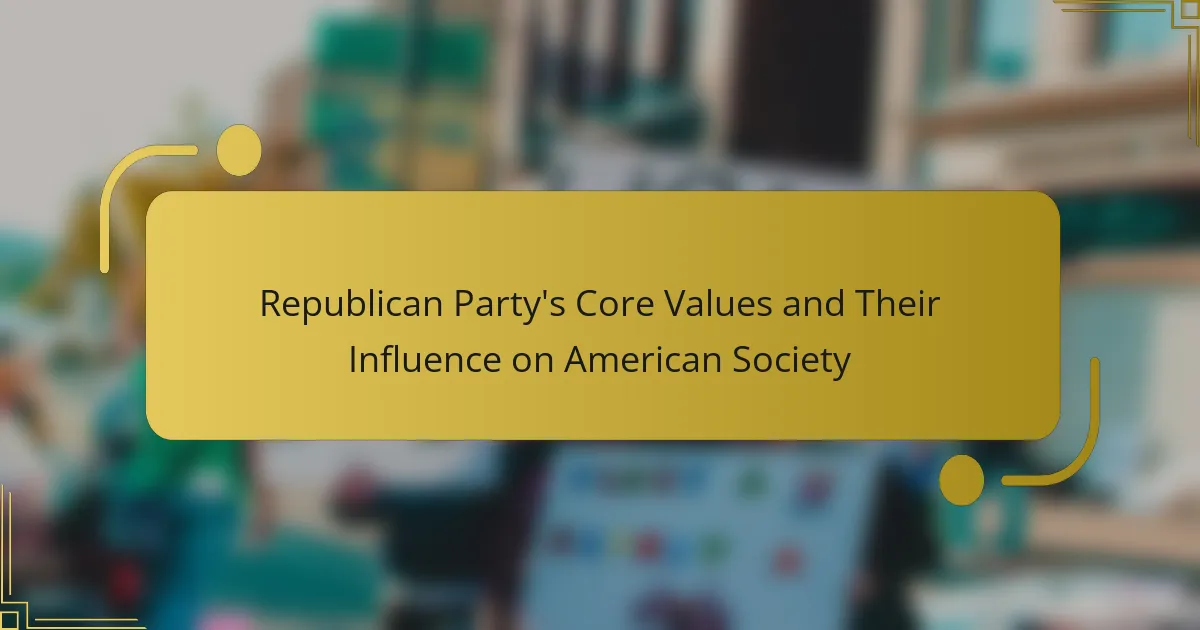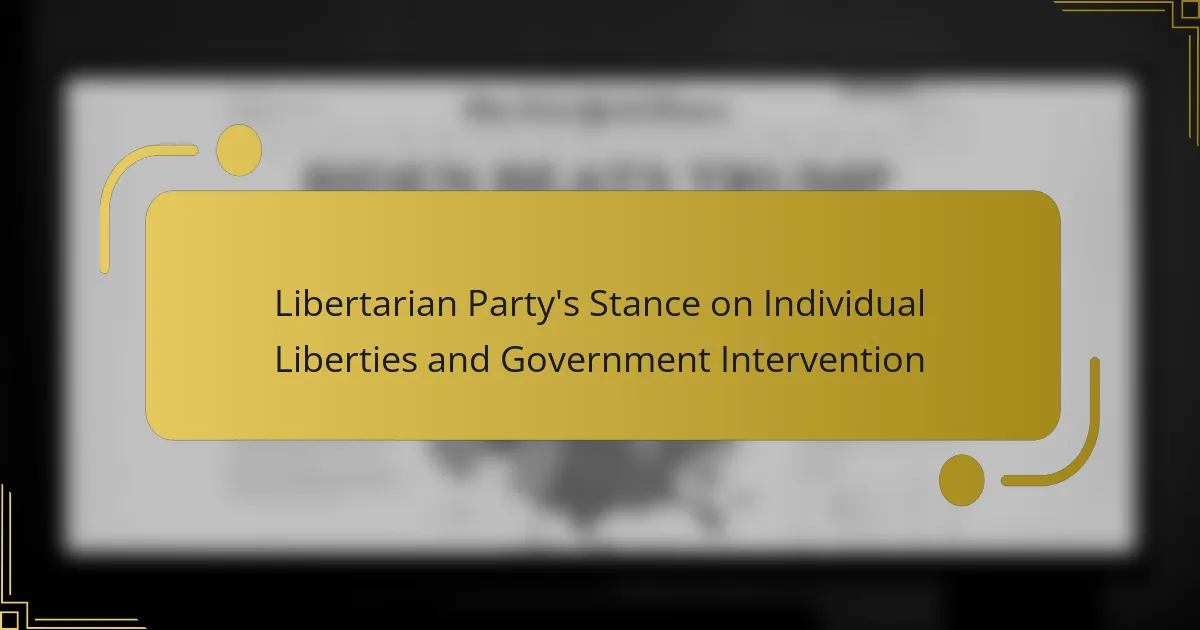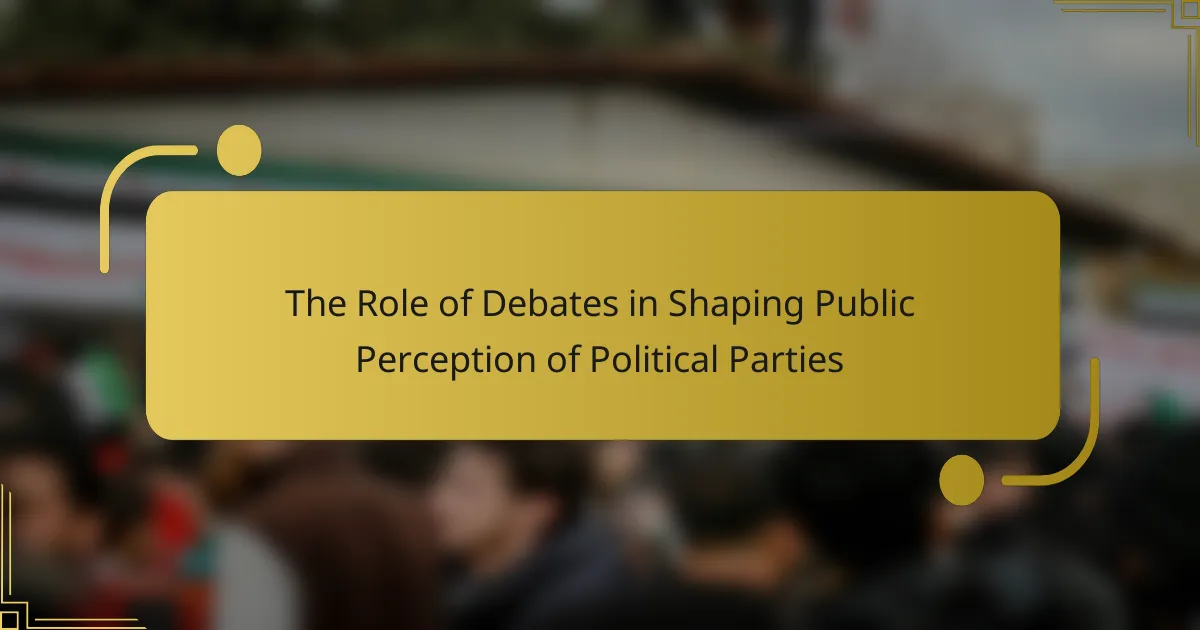Political Action Committees (PACs) are organizations that collect and distribute financial contributions to political campaigns, aiming to influence legislation and election outcomes. This article examines the various funding strategies employed by PACs, including contributions from individuals, corporations, and unions, as well as fundraising events and online crowdfunding. It highlights the regulatory framework established by the Federal Election Commission (FEC), which mandates transparency in PAC contributions and expenditures. The impact of PAC funding on election outcomes is significant, with research indicating that candidates supported by PACs are more likely to win their races and align with specific interest groups’ policy agendas. Overall, the article provides a comprehensive overview of how PACs shape electoral success and influence political priorities.
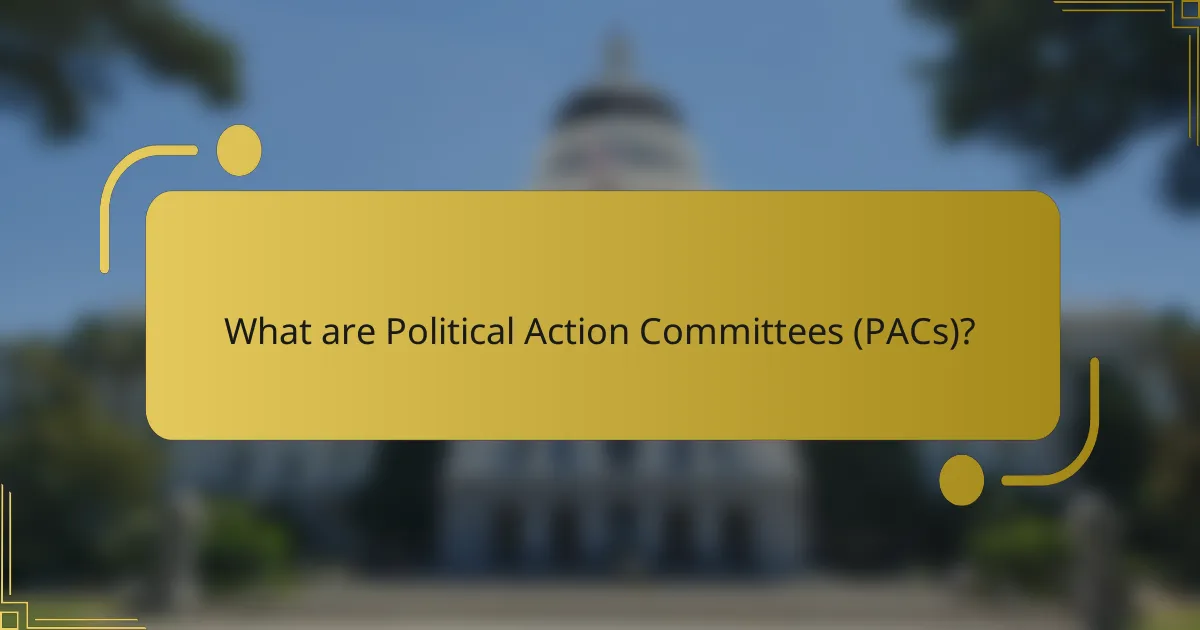
What are Political Action Committees (PACs)?
Political Action Committees (PACs) are organizations that collect and distribute contributions to political campaigns. They aim to influence legislation and election outcomes. PACs can represent various interests, including corporations, labor unions, or ideological groups. They are regulated by the Federal Election Commission (FEC) in the United States. PACs must disclose their contributions and expenditures. This transparency allows for tracking their influence on elections. In 2020, PACs contributed over $1.5 billion to federal candidates. Their funding strategies significantly impact election results and policy decisions.
How do PACs function within the political landscape?
Political Action Committees (PACs) function as organizations that collect and distribute funds to influence political elections. PACs support candidates or parties that align with their interests. They raise money from members and donate to political campaigns. PAC contributions can significantly impact election outcomes. In the 2020 election cycle, PACs contributed over $1.5 billion to federal candidates. This funding can help candidates amplify their messages and reach wider audiences. PACs often focus on specific issues, such as healthcare or education. Their strategic funding can sway public opinion and legislative priorities.
What are the different types of PACs?
The different types of Political Action Committees (PACs) include traditional PACs, leadership PACs, and super PACs. Traditional PACs are organizations that collect contributions to support candidates. They are subject to contribution limits set by federal law. Leadership PACs are established by politicians to support other candidates. They can raise and spend unlimited amounts of money. Super PACs can raise unlimited funds from individuals, corporations, and unions. They cannot coordinate directly with candidates but can spend independently to influence elections. Each type of PAC plays a distinct role in the political funding landscape.
How do PACs collect and distribute funds?
Political Action Committees (PACs) collect funds primarily through voluntary contributions from individuals and organizations. They often solicit donations from members, supporters, and businesses aligned with their political goals. PACs may also host fundraising events to generate financial support.
Once funds are collected, PACs distribute them to candidates, parties, or other PACs that align with their interests. This distribution can occur through direct contributions or independent expenditures supporting specific campaigns.
According to the Federal Election Commission, PACs must adhere to legal contribution limits and reporting requirements. In 2021, PACs contributed over $1.5 billion to federal candidates, showcasing their significant role in election financing.
Why are PACs important in elections?
PACs, or Political Action Committees, are important in elections because they gather and distribute funds to support candidates. They enable individuals and organizations to pool resources for political campaigns. This funding can significantly influence election outcomes by increasing a candidate’s visibility and outreach. According to the Federal Election Commission, PACs contributed over $1 billion to federal candidates in the 2020 election cycle. The financial support from PACs can help candidates run effective campaigns and communicate their messages to voters. Additionally, PACs often represent specific interests, making them crucial in shaping policy agendas. Their involvement can sway public opinion and voter engagement.
What role do PACs play in candidate support?
Political Action Committees (PACs) provide financial support to candidates in elections. They raise funds from individuals and organizations to contribute to campaigns. PACs often align with specific political interests or ideologies. This alignment enables them to support candidates who advocate for their causes. Contributions from PACs can significantly influence a candidate’s visibility and viability. According to the Center for Responsive Politics, PACs contributed over $1.3 billion in the 2020 election cycle alone. This financial backing helps candidates reach more voters through advertising and campaign events. Ultimately, PACs play a crucial role in shaping electoral outcomes by supporting candidates aligned with their interests.
How do PACs influence voter behavior?
Political Action Committees (PACs) influence voter behavior primarily through targeted advertising and financial contributions to candidates. PACs raise funds to support candidates who align with their interests. This financial backing can lead to increased visibility for those candidates. Voters often perceive candidates supported by PACs as more credible or viable. Research shows that candidates with higher PAC funding tend to receive more votes. For example, a study by the Center for Responsive Politics found that candidates receiving significant PAC contributions often outperform their opponents. Additionally, PACs can shape public opinion through issue advocacy campaigns. These campaigns inform voters about specific issues that align with the PAC’s agenda. Overall, PACs play a crucial role in shaping electoral dynamics and influencing voter decisions.
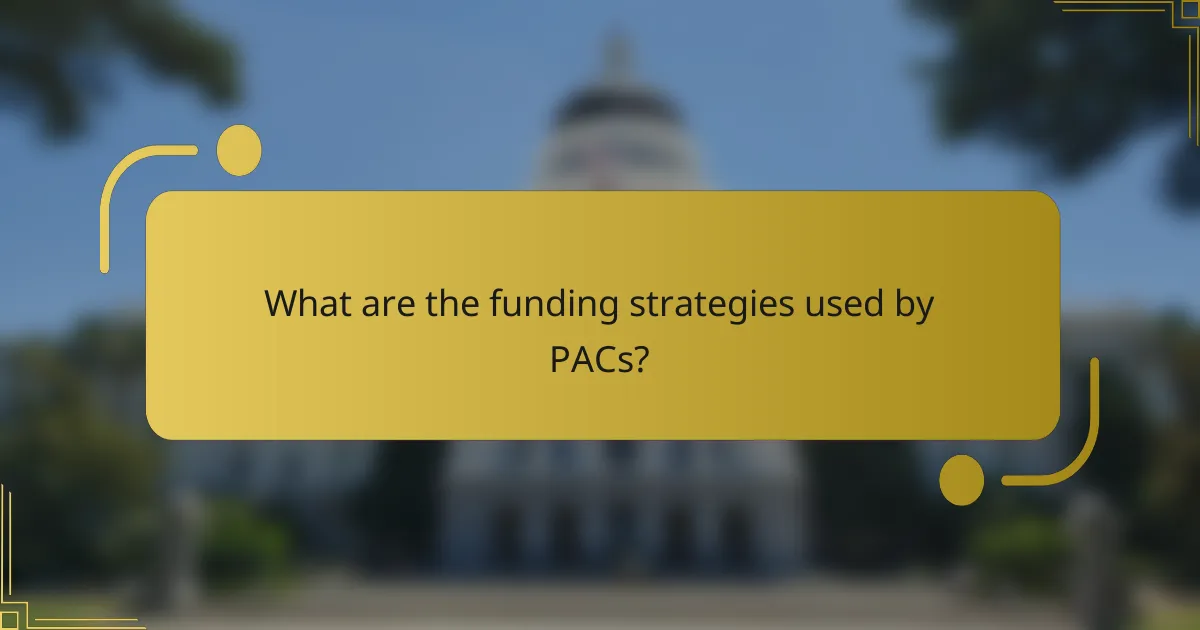
What are the funding strategies used by PACs?
Political Action Committees (PACs) utilize various funding strategies to support candidates and influence elections. These strategies include collecting contributions from individuals, corporations, and unions. PACs often organize fundraising events to gather large sums of money. They also engage in direct mail campaigns to solicit donations from their supporters. Additionally, PACs may form political alliances to pool resources and amplify their financial impact. Many PACs leverage online platforms for crowdfunding, reaching a broader audience. According to the Federal Election Commission, PACs can contribute up to $5,000 per candidate per election cycle. This regulatory framework shapes their funding strategies significantly.
How do PACs determine their funding priorities?
Political Action Committees (PACs) determine their funding priorities based on strategic goals, political alignment, and potential electoral impact. They analyze candidate positions on issues relevant to their interests. PACs often prioritize funding for candidates who support their agenda. They also consider the competitiveness of races when allocating resources. Additionally, PACs assess the likelihood of a candidate’s success in elections. Historical data on electoral outcomes influences funding decisions. Furthermore, PACs may respond to shifts in public opinion on key issues. This systematic approach helps PACs maximize their influence on political outcomes.
What factors influence PAC funding decisions?
Factors influencing PAC funding decisions include political alignment, candidate viability, and issue relevance. Political alignment refers to how closely a candidate’s views match the PAC’s objectives. A strong alignment can lead to increased funding. Candidate viability assesses the likelihood of a candidate winning an election. PACs often prioritize funding candidates with a realistic chance of success. Issue relevance focuses on how critical a specific issue is to the PAC’s mission. PACs are more likely to fund candidates who support their key issues. Additionally, historical contributions and donor preferences also play significant roles in these decisions.
How do PACs allocate funds among candidates?
Political Action Committees (PACs) allocate funds among candidates based on strategic considerations. They assess candidates’ alignment with their political goals and values. PACs often prioritize candidates in key positions or those with a strong chance of winning. They also consider the candidates’ fundraising abilities and overall influence. The allocation process may involve direct contributions or independent expenditures. For example, a PAC may contribute to candidates in competitive races to maximize impact. Additionally, PACs track voting records and public statements to inform their funding decisions. This targeted approach aims to enhance the PAC’s influence in shaping policy outcomes.
What are the legal regulations governing PAC funding?
Legal regulations governing PAC funding are primarily established by the Federal Election Commission (FEC). PACs must register with the FEC and disclose their financial activities. Contributions to PACs are subject to limits set by federal law. For instance, individuals can contribute up to $5,000 per year to a PAC. Corporations and labor unions cannot contribute directly to candidates but can create PACs to raise funds. Additionally, PACs must report their donors and expenditures regularly. These regulations aim to ensure transparency and accountability in political funding.
What are the limits on contributions to PACs?
The limits on contributions to Political Action Committees (PACs) vary based on their type. For federal PACs, individuals can contribute up to $5,000 per year. This limit applies to both traditional PACs and those associated with a specific party. Additionally, PACs can receive up to $15,000 annually from other PACs. These limits are established by the Federal Election Commission (FEC) and are subject to change based on inflation adjustments. The contribution limits are designed to regulate the influence of money in politics and ensure transparency in campaign financing.
How do transparency requirements affect PAC operations?
Transparency requirements significantly influence PAC operations by mandating disclosure of financial activities. These requirements ensure that PACs report their contributions and expenditures. Compliance with transparency laws enhances accountability and public trust. PACs must maintain accurate records to meet these obligations. Failure to comply can result in penalties or loss of credibility. Studies show that transparency can impact donor behavior, as contributors may prefer to support more accountable PACs. Additionally, transparency can affect the strategic decisions of PACs regarding funding and messaging. Overall, transparency requirements shape how PACs operate within the political landscape.
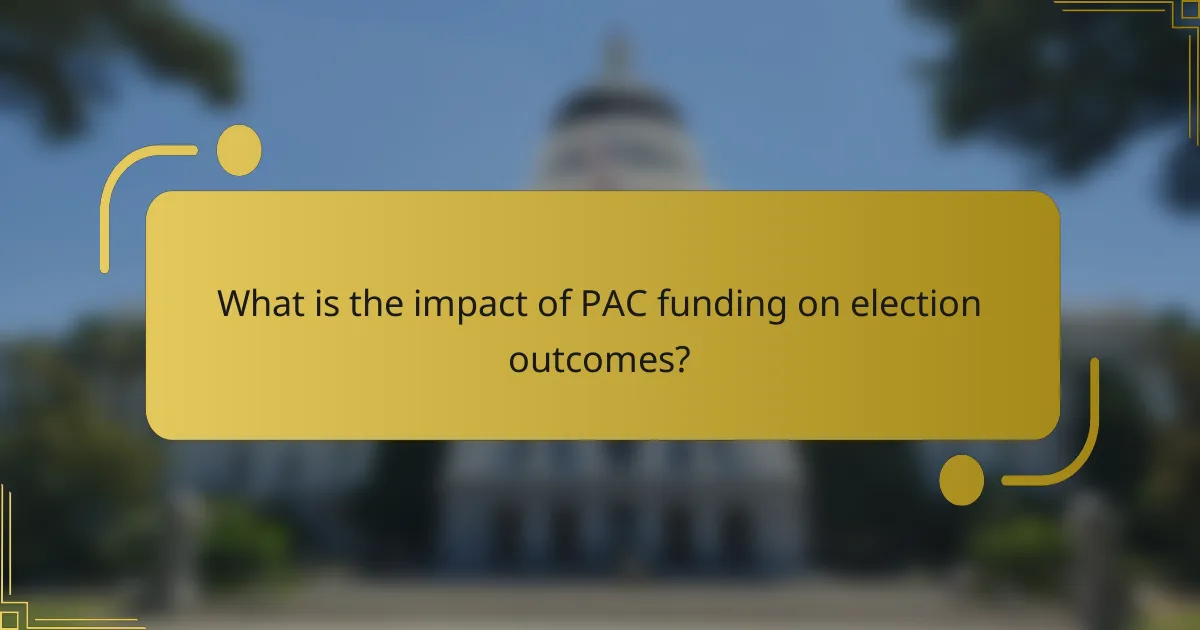
What is the impact of PAC funding on election outcomes?
PAC funding significantly influences election outcomes. Political Action Committees (PACs) provide financial support to candidates, impacting their campaign viability. Candidates with substantial PAC backing often have greater visibility and resources. This increased funding can lead to higher voter outreach and engagement. Research shows that candidates receiving PAC funds are more likely to win elections. For example, a study by the Center for Responsive Politics found that in 2020, candidates with PAC support won approximately 90% of their races. Additionally, PAC funding can shape policy agendas and priorities, aligning candidates with specific interest groups. Overall, PAC funding plays a crucial role in determining electoral success.
How does PAC funding affect candidate success?
PAC funding significantly enhances candidate success in elections. Candidates receiving PAC contributions often have increased visibility and resources. This financial support allows for more extensive campaign advertising and outreach efforts. Studies show that candidates with PAC backing tend to win more often than those without. For instance, a 2018 analysis by the Center for Responsive Politics found that candidates who received PAC money had a 70% success rate in elections. Additionally, PAC funding helps candidates build networks of influence and voter mobilization. Overall, PAC contributions create a competitive advantage that can lead to electoral victories.
What statistical evidence supports PAC influence on elections?
Political Action Committees (PACs) significantly influence elections through funding strategies. Research indicates that candidates receiving PAC contributions often have higher chances of winning. For example, a study by the Center for Responsive Politics found that candidates backed by PACs won 87% of their races in the 2020 election cycle. Additionally, the American Political Science Review published findings showing that PAC spending can sway voter perceptions and increase candidate visibility. Data from the Federal Election Commission reveals that PACs contributed over $1.5 billion in the 2020 elections, indicating their substantial financial impact. These statistics demonstrate the critical role PACs play in shaping electoral outcomes.
How do PACs shape campaign strategies?
Political Action Committees (PACs) shape campaign strategies by providing financial support to candidates. This funding enables candidates to amplify their messaging and outreach efforts. PACs often align with specific political agendas, influencing candidate positions. They can prioritize issues that resonate with their donor base, impacting campaign focus. For example, PACs may fund advertisements that highlight particular policy proposals. This targeted funding can sway public perception and voter engagement. Additionally, PACs may mobilize grassroots efforts to bolster candidate visibility. Their financial backing is crucial in competitive races, often determining campaign viability.
What are the broader implications of PAC funding in politics?
PAC funding significantly influences political dynamics and election outcomes. It allows special interest groups to amplify their voices in the political arena. This funding can lead to increased lobbying efforts, shaping legislation that aligns with the interests of donors. Research indicates that candidates receiving substantial PAC contributions often prioritize donor interests over constituents’ needs. In 2020, over $2 billion was contributed by PACs in federal elections, demonstrating their financial power. Furthermore, PAC funding can create an uneven playing field, favoring well-funded candidates. This can discourage grassroots participation and limit diverse representation in politics. Overall, PAC funding raises concerns about transparency and accountability in the political process.
How do PACs affect public policy decisions?
Political Action Committees (PACs) influence public policy decisions primarily through campaign contributions and lobbying efforts. PACs provide financial support to candidates who align with their interests. This funding can significantly enhance a candidate’s visibility and competitiveness in elections. Consequently, elected officials may prioritize the interests of their PAC donors when making policy decisions. Research indicates that PAC spending correlates with legislative outcomes favoring their agendas. For instance, the Center for Responsive Politics reports that PAC contributions often lead to favorable policy shifts in areas such as healthcare and energy. Thus, PACs play a critical role in shaping public policy through financial influence and strategic lobbying.
What ethical concerns arise from PAC funding practices?
Ethical concerns regarding PAC funding practices include potential corruption and undue influence on political processes. PACs can amass large sums of money, which may lead to favoritism toward certain candidates or policies. This financial power can distort democratic principles by prioritizing the interests of wealthy donors over the general public. Additionally, the lack of transparency in PAC contributions can hinder accountability. Voters may be unaware of who is financing campaigns, complicating informed decision-making. Research indicates that PACs often support candidates aligned with specific corporate interests, raising questions about representation. The Center for Responsive Politics reports that in the 2020 election cycle, PACs contributed over $1.5 billion, highlighting their significant role in shaping electoral outcomes.
What best practices can PACs adopt for effective funding strategies?
Political Action Committees (PACs) can adopt several best practices for effective funding strategies. First, they should establish clear funding goals. This helps prioritize efforts and allocate resources efficiently. Next, diversifying funding sources is crucial. Relying on multiple donors mitigates risk and enhances stability. Building strong relationships with contributors fosters trust and encourages ongoing support. Transparency in financial reporting is essential. It builds credibility and assures donors of responsible fund management. Additionally, leveraging data analytics can optimize fundraising efforts. Targeted outreach based on donor behavior increases engagement. Regularly assessing and adjusting strategies ensures alignment with changing political landscapes. Following these practices can enhance PAC effectiveness and influence election outcomes.
Political Action Committees (PACs) are organizations that collect and distribute funds to influence political campaigns and legislation. This article examines the various funding strategies employed by PACs, including their types, methods of collecting and distributing funds, and the legal regulations governing their operations. It highlights the significant impact of PAC funding on election outcomes, candidate success, and public policy decisions, while also addressing ethical concerns and best practices for effective funding strategies. Overall, the article provides a comprehensive overview of the role PACs play in shaping the political landscape through financial contributions.
